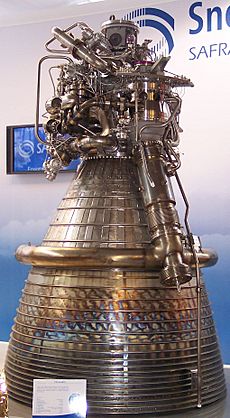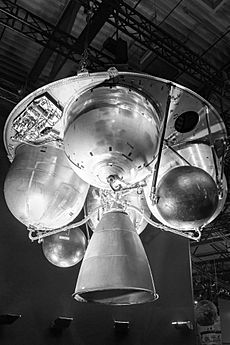Ariane 5 facts for kids

Ariane 5 flight VA-256 on the launch pad with the James Webb Space Telescope in December 2021
|
|
| Function | Heavy launch vehicle |
|---|---|
| Manufacturer | ArianeGroup for ESA |
| Country of origin |
20 ESA member states:
|
| Cost per launch | €150–200 million (as of 2016) |
| Size | |
| Height | 46–52 m (151–171 ft) |
| Diameter | 5.4 m (18 ft) |
| Mass | 777,000 kg (1,713,000 lb) |
| Stages | 2 |
| Capacity | |
| Payload to Low Earth orbit | G: 16,000 kg (35,000 lb) ES: over 20,000 kg (44,000 lb) |
| Payload to GTO |
|
| Associated rockets | |
| Family | Ariane |
| Comparable |
|
| Launch history | |
| Status |
|
| Launch sites | Centre Spatial Guyanais, ELA-3 |
| Total launches | 117
|
| Successes | 112
|
| Failures | 2 (G: 1, ECA: 1) |
| Partial failures | 3 (G: 2, ECA: 1) |
| First flight |
|
| Last flight |
|
| Notable payloads | |
| Boosters (G, G+) – EAP P238 | |
| No. boosters | 2 |
| Length | 31.6 m (104 ft) |
| Diameter | 3.06 m (10.0 ft) |
| Gross mass | 270 t (270 long tons; 300 short tons) |
| Engines | P238 |
| Thrust | 6,650 kN (1,490,000 lbf) |
| Total thrust | 13,300 kN (3,000,000 lbf) |
| Burn time | 130 seconds |
| Fuel | AP, Aluminium, HTPB |
| Boosters (GS, ECA, ES) – EAP P241 | |
| No. boosters | 2 |
| Length | 31.6 m (104 ft) |
| Diameter | 3.06 m (10.0 ft) |
| Empty mass | 33 t (32 long tons; 36 short tons) |
| Gross mass | 273 t (269 long tons; 301 short tons) |
| Engines | P241 |
| Thrust | 7,080 kN (1,590,000 lbf) |
| Total thrust | 14,160 kN (3,180,000 lbf) |
| Burn time | 140 seconds |
| Fuel | AP, Aluminium, HTPB |
| Core stage (G, G+, GS) – EPC H158 | |
| Length | 23.8 m (78 ft) |
| Diameter | 5.4 m (18 ft) |
| Empty mass | 12,200 kg (26,900 lb) |
| Gross mass | 170,500 kg (375,900 lb) |
| Engines | G, G+: Vulcain 1 GS: Vulcain 1B |
| Thrust | 1,015 kN (228,000 lbf) (vacuum) |
| Specific impulse | 440 seconds (vacuum) |
| Burn time | 605 seconds |
| Fuel | LH2 / LOX |
| Core stage (ECA, ES) – EPC H173 | |
| Length | 23.8 m (78 ft) |
| Diameter | 5.4 m (18 ft) |
| Empty mass | 14,700 kg (32,400 lb) |
| Gross mass | 184,700 kg (407,200 lb) |
| Engines | Vulcain 2 |
| Thrust | 960 kN (220,000 lbf) (sea level) 1,390 kN (310,000 lbf) (vacuum) |
| Specific impulse | 310 seconds (sea level) 432 seconds (vacuum) |
| Burn time | 540 seconds |
| Fuel | LH2 / LOX |
| Second stage (G) – EPS L9.7 | |
| Length | 3.4 m (11 ft) |
| Diameter | 5.4 m (18 ft) |
| Empty mass | 1,200 kg (2,600 lb) |
| Gross mass | 10,900 kg (24,000 lb) |
| Engines | Aestus |
| Thrust | 27 kN (6,100 lbf) |
| Burn time | 1100 seconds |
| Fuel | MMH / N2O4 |
| Second stage (G+, GS, ES) – EPS L10 | |
| Length | 3.4 m (11 ft) |
| Diameter | 5.4 m (18 ft) |
| Empty mass | 1,200 kg (2,600 lb) |
| Gross mass | 11,200 kg (24,700 lb) |
| Engines | Aestus |
| Thrust | 27 kN (6,100 lbf) |
| Burn time | 1170 seconds |
| Fuel | MMH / N2O4 |
| Second stage (ECA) – ESC-A | |
| Length | 4.711 m (15.46 ft) |
| Diameter | 5.4 m (18 ft) |
| Empty mass | 4,540 kg (10,010 lb) |
| Gross mass | 19,440 kg (42,860 lb) |
| Engines | HM7B |
| Thrust | 67 kN (15,000 lbf) |
| Specific impulse | 446 seconds |
| Burn time | 945 seconds |
| Fuel | LH2 / LOX |
The Ariane 5 was a powerful European rocket. It was built and launched by a company called Arianespace for the European Space Agency (ESA). It launched from the Guiana Space Centre in French Guiana. This rocket carried satellites and spacecraft into two main types of orbits: GTO (a high orbit) and LEO (a lower orbit around Earth).
Ariane 5 was very reliable, with 82 successful launches in a row from 2003 to 2017. It was designed to be a single-use rocket, meaning it wasn't reused after a launch. Its replacement, the Ariane 6 rocket, has been in development since 2014.
The French space agency, CNES, designed Ariane 5 with help from other European partners. Even though it's not directly based on earlier Ariane rockets, it's still part of the Ariane rocket family. ArianeGroup was the main company in charge of building these rockets. Ariane 5 was first planned to launch the Hermes spaceplane, so it was built to be safe for human space travel.
Over time, Ariane 5 was improved with different versions: "G", "G+", "GS", "ECA", and "ES". It could often launch two large satellites at once using a system called SYLDA. It could even carry up to three smaller main satellites using SPELTRA. Plus, it could take up to eight smaller extra payloads, like tiny satellites or experiments, on an ASAP platform. The last Ariane 5 launches happened before the new Ariane 6 rocket takes over.
Contents
How Does the Ariane 5 Rocket Work?
The Ariane 5 rocket had different parts, or stages, that worked together to push payloads into space.
The Main Engine: Cryogenic Core Stage
The main part of the Ariane 5 was called the EPC (Étage Principal Cryotechnique). This stage used very cold, or cryogenic, fuel. It had a large tank, about 5.4 m (18 ft) wide and 30.5 m (100 ft) tall. This tank held two types of fuel: liquid oxygen and liquid hydrogen.
At the bottom of this main stage was a powerful Vulcain 2 engine. This engine created a huge amount of thrust, about 1,390 kN (310,000 lbf) in space. The entire EPC stage weighed around 189 t (417,000 lb) when full of fuel. After the main stage used up its fuel, it would fall back to Earth and land in the ocean.
Powerful Side Boosters
Attached to the sides of the main stage were two large solid rocket boosters (SRBs). These were also called EAPs. Each booster weighed about 277 t (611,000 lb) when full. They gave the rocket a massive push at launch, with each booster providing about 7,080 kN (1,590,000 lbf) of thrust.
These boosters used a special solid fuel mix. They burned for about 130 seconds before they were released and fell into the ocean. Sometimes, these boosters were recovered from the ocean for scientists to study. However, unlike some other rockets, Ariane 5's boosters were not reused for future launches.
The Second Stage: Upper Stage
Above the main stage and below the payload was the second stage. Early Ariane 5 rockets (like Ariane 5G) used the EPS (Étage à Propergols Stockables) stage. This stage used different types of fuel that could be stored at normal temperatures.
The EPS upper stage was special because it could be started more than once. This was very useful for missions that needed to put spacecraft into specific orbits. For example, it was used to launch the Automated Transfer Vehicle (ATV) to the International Space Station. It would burn, release the ATV, and then burn again to safely de-orbit itself.
Later versions of Ariane 5, like the Ariane 5ECA, used a different second stage called the ESC (Étage Supérieur Cryotechnique). This stage also used liquid hydrogen and liquid oxygen, similar to the main stage. It had an HM7B engine, which was also used on the Ariane 4 rocket. This stage helped control the rocket's movement and released the satellites into their final orbits.
The Fairing: Protecting the Payload
At the very top of the rocket, covering the satellites and upper stages, was the fairing. This was like a nose cone that protected the payload. It kept the satellites safe from heat and air pressure during the rocket's fast climb through the atmosphere. Once the rocket reached a high enough altitude (usually above 100 km (62 mi)), the fairing would split open and fall away.
What Were the Different Ariane 5 Versions?
Over its lifetime, the Ariane 5 rocket was updated and improved. Here are the main versions:
- Ariane 5G (Generic): This was the first version. It could carry about 6,900 kg (15,200 lb) to GTO. It flew 17 times.
- Ariane 5G+: An improved version of the G model, with a better second stage. It could carry slightly more, about 7,100 kg (15,700 lb) to GTO. It flew three times.
- Ariane 5GS: This version used parts from both the G+ and the newer ECA models. It could carry about 6,600 kg (14,600 lb) to GTO. It flew 6 times.
- Ariane 5ECA: This was a major upgrade, first flown successfully in 2005. It had a much stronger main engine (Vulcain 2) and a new, more powerful cryogenic upper stage (ESC-A). It could launch much heavier payloads, up to 11,115 kg (24,504 lb) to GTO in later versions. This was the most common and powerful version.
- Ariane 5ES: This version was similar to the ECA but used the restartable EPS second stage. It was mainly used to launch the Automated Transfer Vehicle (ATV) to the International Space Station and also launched Galileo navigation satellites. It flew 8 times.
Launch system status: Retired · Cancelled · Operational · Under development
What About Ariane 6?
Ariane 6 is the next generation of European rockets, designed to replace Ariane 5. The goal for Ariane 6 was to be cheaper to build and launch. While it was initially planned to be smaller, its final design has a similar performance to Ariane 5. The main focus is on making launches more affordable.
Ariane 6 is expected to cost around €70 million per flight, which is about half the price of an Ariane 5 launch. The first flight of Ariane 6 is expected to happen in 2023.
See also
 In Spanish: Ariane 5 para niños
In Spanish: Ariane 5 para niños
- List of Ariane launches
- Ariane 6, two initial variants
- Heavy-lift launch vehicle
- Comparison of orbital launchers families
- Comparison of orbital launch systems
- Future Launchers Preparatory Programme (ESA, beyond Ariane 5)



